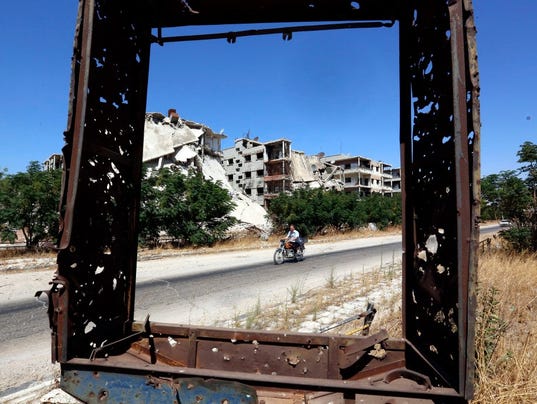
'Bombs rained down on the Al-Waer neighborhood in western Homs in Syria six times one recent day. As they fell, Abu Mahmoud remembered how his 13-year-old son, Mahmoud, and brother-in-law, Hotheifah, 22, died in a similar barrage.
"I was next to them in the house," said Mahmoud, 35, a farmer. "They didn’t have time to run away."
Al-Waer is the last rebel holdout in Syria’s third-largest city. It became a battlefield last month when Syrian President Bashar Assad launched an assault, hoping to score another victory like the fall of rebel-held east Aleppo in December. According to UNICEF, as of January, there were 15 rebel holdouts — enclaves of people living in besieged areas. Mahmoud lives in one of those 15. He moved from his home in southern Homs to Al-Waer when war broke out. In the wake of anti-regime uprisings, Assad’s Shiite Muslim forces brutally repressed the area's largely Sunni community. Mahmoud and his family were part of that community. Mahmoud's youngest child escaped harm in the airstrike in February that killed his 13-year-old. His wife and middle son were injured.
"We needed a big wasta to let them out," he said. "Wasta" is an Arabic term meaning an inside connection.
A friend spirited them through government lines to a hospital elsewhere in the city. They were released three days ago and live in a regime-controlled part of Homs.
Mahmoud vows to defy Assad until death. "We are not leaving," he said. "We will stay a thorn in the regime’s throat. God gives, and God takes."
"We needed a big wasta to let them out," he said. "Wasta" is an Arabic term meaning an inside connection.
A friend spirited them through government lines to a hospital elsewhere in the city. They were released three days ago and live in a regime-controlled part of Homs.
Mahmoud vows to defy Assad until death. "We are not leaving," he said. "We will stay a thorn in the regime’s throat. God gives, and God takes."
Al-Waer was under siege long before the latest assault. United Nations humanitarian aid convoys have kept residents alive for more than three years. The regime blocked the last U.N. convoy from entering Al-Waer late last month, threatening 75,000 people with starvation. Similar blockades have gone up in other rebel-held pockets around Homs.
"What has changed in recent weeks is the intensity of the siege and bombing," said Ayoub Shabil, 47, an agricultural engineer in Ar Rastan, a small town 15 miles north of Homs. "You can’t imagine how small these houses are compared to the size of the rockets hitting them. Three rockets destroyed 12 homes here on Monday. The siege is getting worse."
Mouhannad al-Khaled, 25, a photographer and activist in Al-Waer for three years, said that when he arrived in the neighborhood, it was almost empty and full of new buildings. Today, those streets are mostly lined with rubble or buildings severely damaged after years of airstrikes and fighting. Residents who remain share the few habitable buildings still standing. Mohammad al-Hosami, a former Red Crescent activist living in Al-Waer for five years, said rebels and the regime signed a cease-fire March 6 set to last 10 days. The two sides have begun negotiations on evacuating the neighborhood. Those who stay must give up their weapons. The Russians are there to ensure the agreement. It's anyone's guess if it happens, residents said. Al-Hosami said he expects most to evacuate because the conditions are becoming unbearable and people are losing hope.
"Sadness is prevailing in the streets," he said. "Al-Waer was the last holdout for rebels in Homs. If its residents leave, it’s the end for the revolution in the city." '
"What has changed in recent weeks is the intensity of the siege and bombing," said Ayoub Shabil, 47, an agricultural engineer in Ar Rastan, a small town 15 miles north of Homs. "You can’t imagine how small these houses are compared to the size of the rockets hitting them. Three rockets destroyed 12 homes here on Monday. The siege is getting worse."
Mouhannad al-Khaled, 25, a photographer and activist in Al-Waer for three years, said that when he arrived in the neighborhood, it was almost empty and full of new buildings. Today, those streets are mostly lined with rubble or buildings severely damaged after years of airstrikes and fighting. Residents who remain share the few habitable buildings still standing. Mohammad al-Hosami, a former Red Crescent activist living in Al-Waer for five years, said rebels and the regime signed a cease-fire March 6 set to last 10 days. The two sides have begun negotiations on evacuating the neighborhood. Those who stay must give up their weapons. The Russians are there to ensure the agreement. It's anyone's guess if it happens, residents said. Al-Hosami said he expects most to evacuate because the conditions are becoming unbearable and people are losing hope.
"Sadness is prevailing in the streets," he said. "Al-Waer was the last holdout for rebels in Homs. If its residents leave, it’s the end for the revolution in the city." '
No comments:
Post a Comment